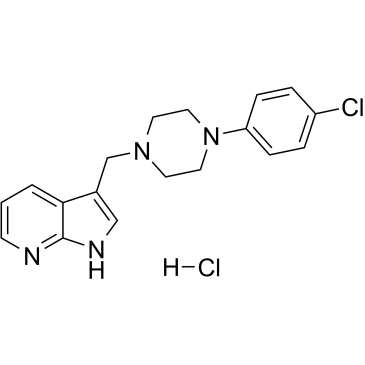1173023-36-3
| Name | L-745870 hydrochloride |
|---|
| Description | L-745870 hydrochloride is a high-affinity, selective and orally active human dopamine D4 receptor antagonist with a Ki of 0.43 nM, and considerably weaker D2 (Ki of 960 nM) and D3 (Ki of 2300 nM) receptors affinity. L-745870 hydrochloride has excellent brain penetration[1][2][3]. |
|---|---|
| Related Catalog | |
| Target |
Ki: 0.43 nM (Human dopamine D4 receptor), 960 nM (Human dopamine D2 receptor), 2300 nM (Human dopamine D3 receptor)[1][3] |
| In Vitro | In vitro pharmacological studies revealed that L-745870 is an antagonist at human D4 receptors, in that L-745870 is capable of antagonizing the ability of D4 receptors to inhibit agonist-induced stimulation of [35S]-GTPgS binding; blocking the inhibition of forskolin-stimulated adenylate cyclase activity in transfected human embryonic kidney (HEK293) and Chinese hamster ovary (CHO) cells; blocking dopamine-induced inhibition of Ca2+ currents in transfected GH4C1 pituitary cells; inhibiting D4 activation of cloned G protein-coupled inwardly rectifying K+ channels; and antagonizing dopamine-induced stimulation of extracellular acidification in transfected cells[1][2]. |
| In Vivo | L-745870 has good pharmacokinetic properties (20-60% oral bioavailability and plasma t1/2 2.1-2.8 hours) in both rat and monkey, and excellent brain penetration with high brain to plasma ratios in rat[2]. Evaluation of L-745870 in surrogate marker assays demonstrates that this compound is freely available for biological activity in the brain and that at doses of 5 to 60 mg/kg p.o. L-745870 would occupy 50% D4 receptors in the brain. L-745870 has no effect on apomorphine-induced stereotypy in rats but does induce catalepsy in mice, albeit at a high dose of 100 mg/kg p.o. that is likely to occupy D2 receptors in vivo. High doses of L-745870 might also be expected to cause extrapyramidal symptoms in primates because the levels in the CNS at these doses would be sufficient to antagonize D2 receptors. Following oral administration to squirrel monkeys, L745870 (10 mg/kg p.o.) induces mild sedation and extrapyramidal motor symptoms, notably bradykinesia, became apparent at 30 mg/kg. Lower doses of L-745870 has no observable behavioural effects in monkeys[1][2]. |
| References |
| Molecular Formula | C18H20Cl2N4 |
|---|---|
| Molecular Weight | 363.28 |
| Hazard Codes | Xi |
|---|
